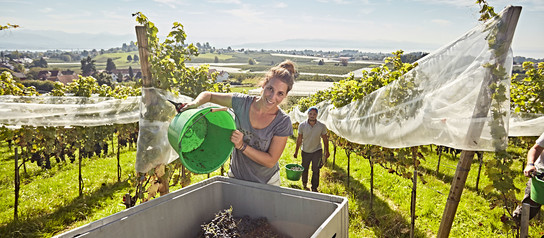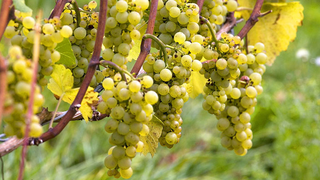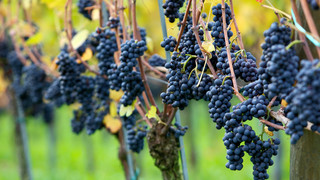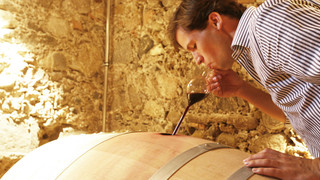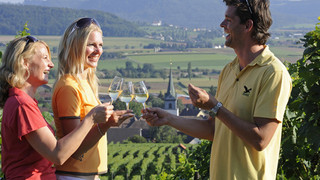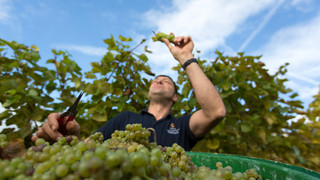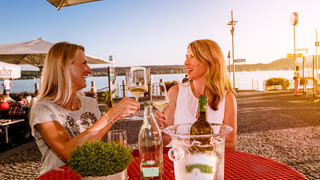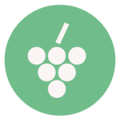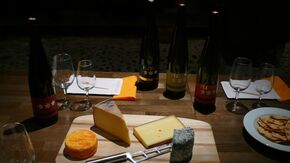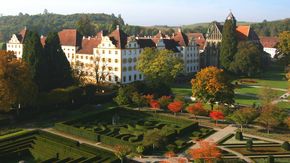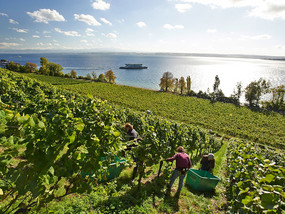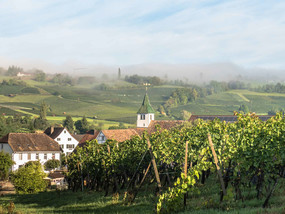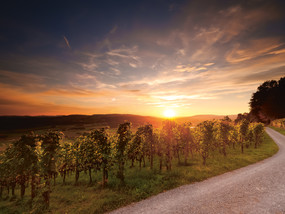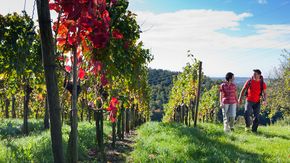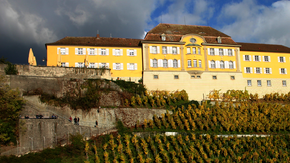Wine on Lake Constance
No borders enjoyment in the four-country region
Lake Constance Stars
The most beautiful sites above Lake Constance traditionally belong to vineyards. The Müller-Thurgau, Pinot Gris, Pinot Blanc and Pinot Noir grapes enjoy sunny lake views from the Rhine Valley to the Rhine Falls. Viticulture has shaped the landscape and the people here for centuries. Everything that makes the hearts of wine fans beat faster can be found around the lake: Unforgettable wine excursion destinations, events, wine hiking trails, bookable experiences and accommodation offers.
Six growing regions - one wine region
Wine has been produced here for a very long time on the German bank and Rhine Valley in the cantons of St.Gallen, Thurgau, and Blauburgunderland around Schaffhausen, Switzerland — as well as Liechtenstein and Vorarlberg, Austria.
All of the wine-growing areas benefit from the special climatic conditions: Lake Constance acts as a heat regulator that balances out temperature fluctuations and reflects solar energy. Nevertheless, all regions have their own character because the grapes grow on different soils, (terroir) and are crafted further by the hands of the winegrower. In addition to the regional "classics" Müller-Thurgau and Pinot Noir, other cultivars include Sauvignon blanc, Chardonnay and many more.
The top wine experiences at Lake Constance ...
- Enjoy a glass of Lake Constance wine in a tavern along the shoreline
- Climb Germany's highest vineyard, the “Hohentwiel” in Singen
- Visit one of the many wine festivals
- Enjoy a beautiful wine views of Baden at the Lerchenberg memorial in Meersburg
- Taste from the Court Winery of the Princely Family of Liechtenstein
- Learn exciting things about viticulture on wine hiking trails
- Visit the largest continuous vineyard landscape in German-speaking Switzerland, the Blauburgunderland
- Visit the westernmost “Heurige” or wine tavern of Austria in the capital city of Bregenz
Wine experiences at a glance
If you would like to learn more about Lake Constance wine, you’re in the right place:
you’ll find more at selected wineries, passionate winemakers and in expert museums.
Book your wine experiences
Wine becomes an experience with exceptional tastings and special arrangements for individuals and groups. Click here for an overview of these and other bookable wine offers at Lake Constance
Wine hiking trails
Discover the countryside, stroll through vineyards and enjoy typical regional dishes on the way to the wine. Whether by bike or hiking boots, get very close to the vines on these tours. There are additional wine tours in the Bodenee Tourenportal »
Accommodation offers
Stay overnight at the winegrower's ... even in a wine barrel! Suitable arrangements round off your pleasure vacation in the Lake Constance wine region.
German Wine Smugglers – the Müller-Thurgau Story
On a spring night in 1925, two local young men secretly set off in a row boat. Their fathers eagerly awaited their return home from the Swiss side. The young men had 400 grafted vines in their boat. Johann Baptiste Röhrenbach was determined to cultivate Müller-Thurgau grapes after tasting it for the first time at Arenenberg Castle on the Swiss side of Bodensee. He was so smitten with the refreshing white wine that he decided to smuggle the vines back home. The variety was a new hybrid showing superstar promise in the wine world and he knew this early ripening grape was ideal for cultivation in Germany. After the successful smuggling operation, Röhrenbach began to cultivate the wine, but was only allowed to press small quantities in Immenstaad. The new wine soon became the hot topic among connoisseurs and in spring 1926, the wine thief repeated his smuggling tour and secretly distributed vines to interested winegrowers. Today, Müller-Thurgau is the most widely cultivated grape in the region.
Further information
The wine associations around Lake Constance are competent partners for all aspects of Lake Constance wine: from the winegrowers and wineries to the grape varieties and tastings.
Header picture: www.bayern.by - Gert Krautbauer
